

Play Dot Sound. Aaron Brown Sound. ELIAS Software – Adaptive Game Music. Some simple math for figuring out your game's audio budget. In this reprint from the September 2005 issue of Game Developer magazine, composer Alexander Brandon (The Elder Scrolls V: Skyrim) shares some useful formulas for determining the audio budget of your game.

When we audio folk are engaging in the more fun side of game audio, we're sitting around the campfire strumming Martin Backpacker guitars, fudging with Kyma and a Korg Kaoss Pad on the laptop, and figuring out how to squeeze a thousand sounds into 32K of memory. Yet, there's a harsher reality emerging in recent days: our budgets. Without a keen understanding of what really goes into an audio budget, content creators and directors alike will encounter some nasty pitfalls in today's game development environment.
More and more, game budgets seem to encounter cost overruns, and while I can't make an analysis of an entire game budget in one column, let's take a look at some techniques that can help your audio budget stay on target. Music. SFX. Voice over. Integration. Is Game Music All It Can Be? This is a love song.

A love song to video game music. A love song to video game music that spends a lot of time pointing out that video game music would do well to iron its shirt, shower every day, and would it kill it to maybe shave every once in a while? This piece is directed toward those who make, compose for, and/or enjoy a cinematic game experience common to most triple-A and an increasing number of indie titles. It touches on elements common to all video games in many places, but the purpose is not to play the nagging Jewish mother to two-man developers about how they should be more like their big brother who graduated summa cum laude and landed a big contract with Activision and will probably cure cancer someday. The purpose is to help producers communicate with their composers, help composers hone their craft, and help the end consumer become more educated about the potential value of game music. 8-Bit Analysis. Main/Songs in the Key of Panic.
A timer reaches 100.
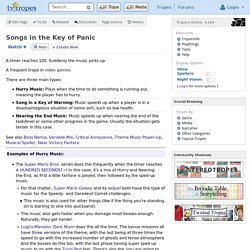
Suddenly the music picks up. Battle Intro. "Dispatched, in mankind's darkest hour, we are the knights of the blue flame!
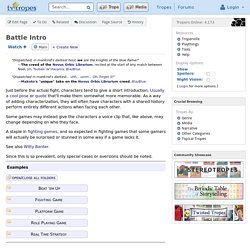
" Just before the actual fight, characters tend to give a short introduction. Usually a cool pose or quote that'll make them somewhat more memorable. As a way of adding characterization, they will often have characters with a shared history perform entirely different actions when facing each other. Some games may instead give the characters a voice clip that, like above, may change depending on who they face. Tracksounds (The Blog): New York Times's Article on Video Game Music.
This great article was published by the NEW YORK TIMES back in late December.
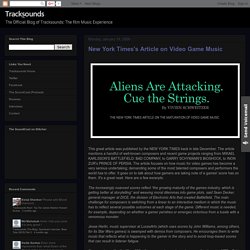
The article mentions a handful of well-known composers and recent game projects ranging from MIKAEL KARLSSON'S BATTLEFIELD: BAD COMPANY, to GARRY SCHYMANN'S BIOSHOCK, to INON ZUR's PRINCE OF PERSIA. The article focuses on how music for video games has become a very serious undertaking; demanding some of the most talented composers and performers the world has to offer. It goes on to talk about how gamers are taking note of a games' score has on them. Thematic Unity Across a Video Game Series. Von Jason Brame Zusammenfassung.
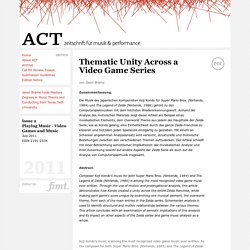
Die Musik des japanischen Komponisten Koji Kondo für Super Mario Bros. (Nintendo, 1984) und The Legend of Zelda (Nintendo, 1986) gehört zu den Computerspielmusiken mit dem höchsten Wiedererkennungswert. Anhand der Analyse des motivischen Materials zeigt dieser Artikel am Beispiel eines musikalischen Elements, dem Overworld Theme aus jedem der Hauptteile der Zelda-Serie, wie es Kondo gelang, eine Einheitlichkeit durch das ganze Zelda-Franchise zu kreieren und trotzdem jeden Spielscore einzigartig zu gestalten. Mit einem an Schenker angelehnten Analyseansatz wird versucht, strukturelle und motivische Beziehungen zwischen den verschiedenen Themen aufzudecken. Abstract. Ocarina songs in The Legend of Zelda: Ocarina of Time.
This originally appeared as a series on my now-defuct games and music blog Cruise Elroy in 2008, and an abridged version appeared in issue 5 of Kill Screen in 2011.
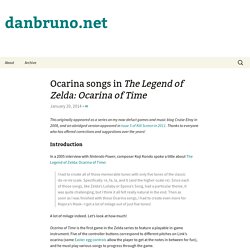
Thanks to everyone who has offered corrections and suggestions over the years! Introduction In a 2005 interview with Nintendo Power, composer Koji Kondo spoke a little about The Legend of Zelda: Ocarina of Time: I had to create all of those memorable tunes with only five tones of the classic do-re-mi scale. Specifically: re, fa, la, and ti (and the higher-scale re). Sound Librarian - Home. Game Design at Indiana University Bloomington.
GQ Audio GQ Audiosound & music for game developmentIU Bloomington Game Quarry Game Quarry is part of the game design program at the Indiana University Media School.
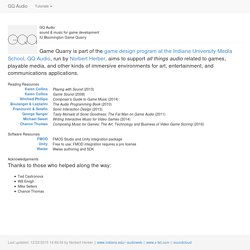
GQ Audio, run by Norbert Herber, aims to support all things audio related to games, playable media, and other kinds of immersive environments for art, entertainment, and communications applications. Reading Resources. Game Audio Tutorial – How To Create Seamless Looping Music and Sound Effects Files for Video Games. If you are watching on a mobile device you won’t see the helpful annotations or be able to skip around.
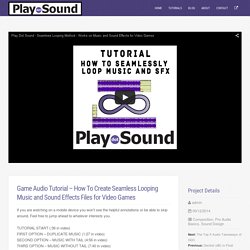
Feel free to jump ahead to whatever interests you. TUTORIAL START (:36 in video) FIRST OPTION – DUPLICATE MUSIC (1:27 in video) SECOND OPTION – MUSIC WITH TAIL (4:56 in video) THIRD OPTION – MUSIC WITHOUT TAIL (7:40 in video) LOOPING AMBIENCE AND SFX (10:06 or 12:00 in video) Hey there Audio Compadres When creating music and doing sound design for video games there are a multitude of reasons that sounds need to loop.
Oddly enough, most professionals don’t really discuss their methods on how they accomplish this. In each case, the method involves variations of the sames thing: Basically, you take a file, make an edit, take the tail end of that edit, put this tail end edit to the front end of the file, and find a good way to crossfade between them smoothly. I prefer to do the fades of the files on two separate tracks instead of the crossfade tool on a single track.